Applying NMR T2 Spectral Parameters in Pore Structure Evaluation—An Example from an Eocene Low-Permeability Sandstone Reservoir
Abstract
:1. Introduction
2. Geological Background
3. Sampling and Methodology
3.1. Samples and Analytical Techniques
3.2. MICP Methodologies
3.3. NMR Methodologies
3.3.1. NMR Measurement
3.3.2. NMR T2 Spectral Parameters
3.3.3. Pore Components Derived from NMR T2 Spectra
4. Results
4.1. Petrophysical Properties and Pore Types
4.2. Pore Throat Size Distribution from MICP Measurements
4.3. Micro-Fracture Analysis
4.4. NMR Experiments and Data Analysis
4.4.1. NMR T2 Spectral Analysis
4.4.2. Effective Movable Fluid in Pore Space
5. Discussions
5.1. Relationships between NMR T2 Spectral Parameters and Petrophysical Properties
5.2. Comparison of NMR T2 Spectral Parameters and MICP Capillary Parameters
5.3. Application of NMR T2 Spectral Analysis in Pore Structure Evaluation
6. Conclusions
- (1)
- Petrographic analysis reveals that the pore systems in the Eocene sandstone are composed mainly of residual intergranular pores, dissolution pores, micropores, and a minor amount of micro-fractures.
- (2)
- The T2gm, T2mid, S3, and φem parameters have positive relationships with permeability, suggesting that the proportion of large and effective pores has a profound control on the overall permeability of the sandstones. Thus, the permeability of the Eocene sandstone is mainly dominated by large pore systems.
- (3)
- The NMR T2 spectral parameters exhibit excellent correlations with MICP capillary parameters, indicating that the NMR T2 spectral parameters also contain rich information on pore structures and movable fluids. Thus, pore structures, pore fluid distribution, and reservoir permeability can be effectively evaluated by using NMR T2 spectral parameters.
- (4)
- A comprehensive classification scheme of the Eocene sandstones is established based on NMR T2 spectral parameters while considering the petrophysical properties and macroscopic behaviors. The Es4 sandstone reservoirs are classified into four types of pore structures (I, II, III, and IV). Type I and II pore structures exhibit good petrophysical properties and microscopic connectivity. Our study demonstrates the effectiveness and applicability of the NMR technique in characterizing low-permeability sandstone reservoirs and provides a basis for further improving reservoir quality evaluation in the Bohai Bay Basin, China. However, limited by the quantity of NMR experimental data, continuous evaluation of pore structure throughout entire reservoir intervals would not be feasible. The combination of NMR experimental data and NMR logging or conventional logging data would be crucial for further extending these research findings.
Author Contributions
Funding
Institutional Review Board Statement
Informed Consent Statement
Data Availability Statement
Conflicts of Interest
Appendix A

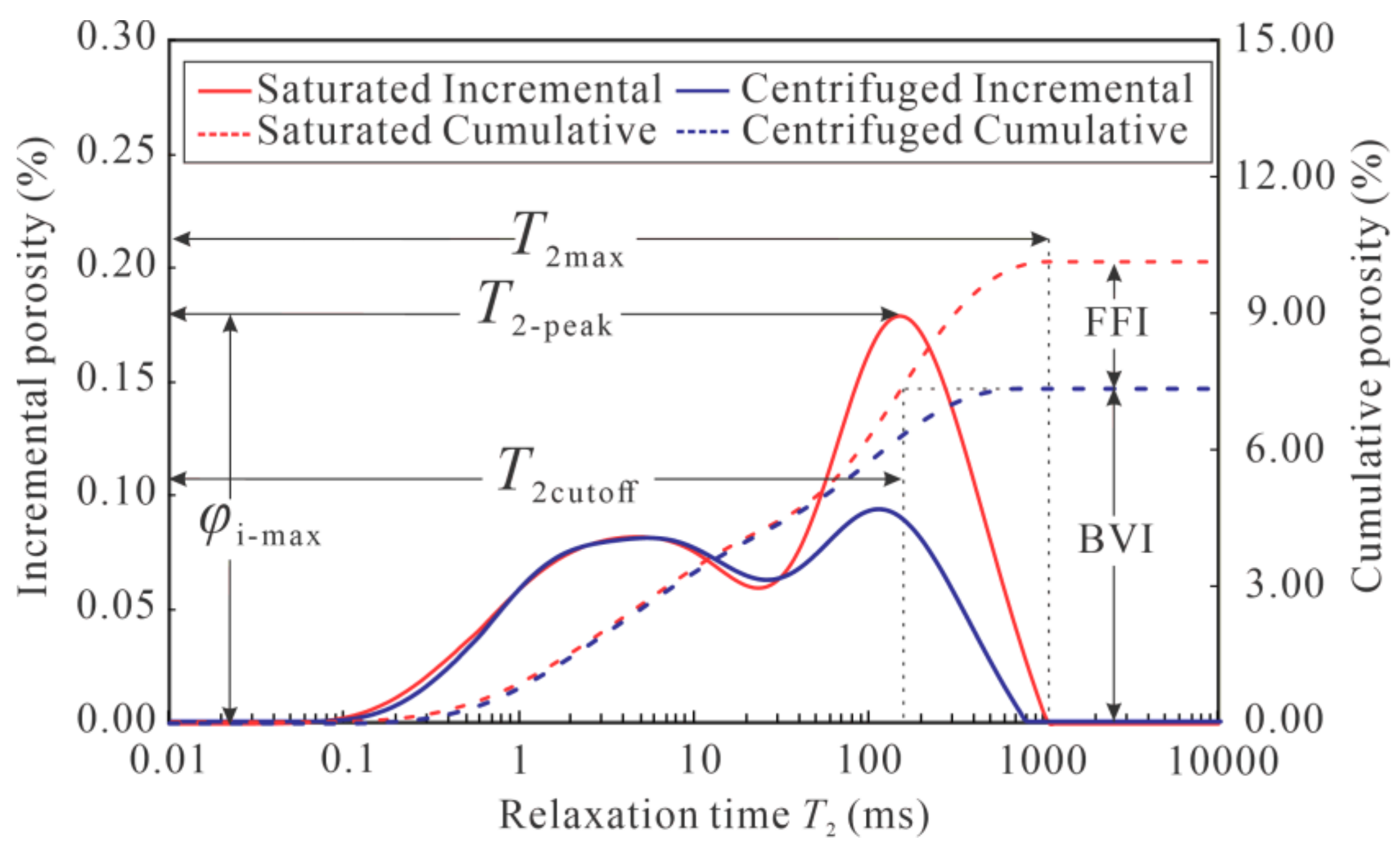

References
- Yuan, G.; Gluyas, J.; Cao, Y.; Oxtoby, N.H.; Jia, Z.; Wang, Y.; Li, X. Diagenesis and reservoir quality evolution of the Eocene sandstones in the northern Dongying Sag, Bohai Bay Basin, East China. Mar. Pet. Geol. 2015, 62, 77–89. [Google Scholar] [CrossRef]
- Zahid, M.A.; Chunmei, D.; Lin, C.; Gluyas, J.; Jones, S.; Zhang, X.; Munawar, M.J.; Ma, C. Sequence stratigraphy, sedimentary facies and reservoir quality of Es4s, southern slope of Dongying Depression, Bohai Bay Basin, East China. Mar. Petrol. Geol. 2016, 77, 448–470. [Google Scholar] [CrossRef]
- Lu, Y.; Liu, K. Pore structure characterization of Eocene low-permeability sandstones via fractal analysis and machine learning: An example from the Dongying Depression, Bohai Bay Basin, China. ACS Omega 2021, 6, 11693–11710. [Google Scholar] [CrossRef] [PubMed]
- Ajdukiewicz, J.M.; Lander, R.H. Sandstone reservoir quality prediction: The state of the art. AAPG Bull. 2010, 94, 1083–1091. [Google Scholar] [CrossRef]
- Blunt, M.J.; Bijeljic, B.; Dong, H.; Gharbi, O.; Iglauer, S.; Mostaghimi, P.; Paluszny, A.; Pentland, C. Pore-scale imaging and modelling. Adv. Water Resour. 2013, 51, 197–216. [Google Scholar] [CrossRef] [Green Version]
- Medina, C.; Mastalerz, M.; Rupp, J. Characterization of porosity and pore-size distribution using multiple analytical tools: Implications for carbonate reservoir characterization in geologic storage of CO2. Environ. Geosci. 2017, 24, 51–72. [Google Scholar] [CrossRef]
- Jiu, B.; Huang, W.; He, M.; Lv, C.; Liang, F. Quantitative analysis of micron-scale and nano-scale pore throat characteristics of tight sandstone using matlab. Appl. Sci. 2018, 8, 1272. [Google Scholar] [CrossRef] [Green Version]
- Weger, R.J.; Eberli, G.P.; Baechle, G.T.; Massaferro, J.L.; Sun, Y.F. Quantification of pore structure and its effect on sonic velocity and permeability in carbonates. AAPG Bull. 2009, 93, 1297–1317. [Google Scholar] [CrossRef]
- Rezaee, R.; Saeedi, A.; Clennell, B. Tight gas sands permeability estimation from mercury injection capillary pressure and nuclear magnetic resonance data. J. Pet. Sci. Eng. 2012, 88–89, 92–99. [Google Scholar] [CrossRef] [Green Version]
- Song, W.; Wang, D.; Yao, J.; Li, Y.; Sun, H.; Yang, Y.; Zhang, L. Multiscale image-based fractal characteristic of shale pore structure with implication to accurate prediction of gas permeability. Fuel 2019, 241, 522–532. [Google Scholar] [CrossRef]
- Mozley, P.S.; Heath, J.E.; Dewers, T.A.; Bauer, S.J. Origin and heterogeneity of pore sizes in the Mount Simon sandstone and Eau Claire formation: Implications for multiphase fluid flow. Geosphere 2016, 12, 1341–1361. [Google Scholar] [CrossRef]
- Mehrabi, H.; Esrafili-Dizaji, B.; Hajikazemi, E.; Noori, B. Reservoir characterization of the Burgan Formation in northwestern Persian Gulf. J. Pet. Sci. Eng. 2019, 174, 328–350. [Google Scholar] [CrossRef]
- Nelson, P. Pore-throat sizes in sandstones, tight sandstones, and shales. AAPG Bull. 2009, 93, 329–340. [Google Scholar] [CrossRef]
- Anovitz, L.M.; Cole, D.R. Characterization and analysis of porosity and pore structures. Rev. Mineral. Geochem. 2015, 80, 61–164. [Google Scholar] [CrossRef] [Green Version]
- Tsakiroglou, C.D.; Payatakes, A.C. Characterization of the pore structure of reservoir rocks with the aid of serial sectioning analysis, mercury porosimetry and network simulation. Adv. Water Resour. 2000, 23, 773–789. [Google Scholar] [CrossRef]
- Hollis, C.; Vahrenkamp, V.; Tull, S.; Mookerjee, A.; Taberner, C.; Huang, Y. Pore system characterization in heterogeneous carbonates: An alternative approach to widely-used rock-typing methodologies. Mar. Pet. Geol. 2010, 27, 772–793. [Google Scholar] [CrossRef]
- Kassab, M.A.; Hashish, M.F.A.; Nabawy, B.S.; Elnaggar, O.M. Effect of kaolinite as a key factor controlling the petrophysical properties of the Nubia sandstone in central Eastern desert. Egypt. J. Afr. Earth Sci. 2017, 125, 103–117. [Google Scholar] [CrossRef]
- Bera, B.; Mitra, S.K.; Vick, D. Understanding the micro structure of Berea sandstone by the simultaneous use of micro-computed tomography (micro-CT) and focused ion beam-scanning electron microscopy (FIB-SEM). Micron 2011, 42, 412–418. [Google Scholar] [CrossRef] [PubMed]
- Chalmers, G.R.L.; Bustin, R.M.; Power, I.M. Characterization of gas shale pore systems by porosimetry, pycnometry, surface area, and field emission scanning electron microscopy/transmission electron microscopy image analyses: Examples from the Barnett, Woodford, Haynesville, Marcellus, and Doig units. AAPG Bull. 2012, 96, 1099–1119. [Google Scholar] [CrossRef]
- Nooruddin, H.A.; Hossain, M.E.; Al-Yousef, H.; Okasha, T. Comparison of permeability models using mercury injection capillary pressure data on carbonate rock samples. J. Pet. Sci. Eng. 2014, 121, 9–22. [Google Scholar] [CrossRef]
- Lai, J.; Wang, G. Fractal analysis of tight gas sandstones using high-pressure mercury intrusion techniques. J. Nat. Gas Sci. Eng. 2015, 24, 185–196. [Google Scholar] [CrossRef]
- Fang, X.; Cai, Y.; Liu, D.; Zhou, Y. A mercury intrusion porosimetry method for methane diffusivity and permeability evaluation in coals: A comparative analysis. Appl. Sci. 2018, 8, 860. [Google Scholar] [CrossRef] [Green Version]
- Al-Raoush, R.I.; Willson, C.S. Extraction of physically realistic pore network properties from three-dimensional synchrotron X-ray microtomography images of unconsolidated porous media systems. J. Hydrol. 2005, 300, 44–64. [Google Scholar] [CrossRef]
- Bultreys, T.; de Boever, W.; Cnudde, V. Imaging and image-based fluid transport modeling at the pore scale in geological materials: A practical introduction to the current state-of-the-art. Earth Sci. Rev. 2016, 155, 93–128. [Google Scholar] [CrossRef]
- Fang, H.H.; Sang, S.X.; Liu, S.Q. Three-dimensional spatial structure of the macro-pores and flow simulation in anthracite coal based on X-ray μ-CT scanning data. Petrol Sci. 2020, 17, 1221–1236. [Google Scholar] [CrossRef]
- Clarkson, C.R.; Freeman, M.; He, L.; Agamalian, M.; Melnichenko, Y.B.; Mastalerz, M.; Radlinski, A.P.; Blach, T.P. Characterization of tight gas reservoir pore structure using usans/sans and gas adsorption analysis. Fuel 2012, 95, 371–385. [Google Scholar] [CrossRef]
- Tripathy, A.; Kumar, A.; Srinivasan, V.; Singh, K.H.; Singh, T.N. Fractal analysis and spatial disposition of porosity in major indian gas shales using low-pressure nitrogen adsorption and advanced image segmentation. J. Nat. Gas Sci. Eng. 2019, 72, 103009. [Google Scholar] [CrossRef]
- Doveton, J.; Watney, L. Textural and pore size analysis of carbonates from integrated core and nuclear magnetic resonance logging: An Arbuckle study. Interpretation 2014, 3, SA77–SA89. [Google Scholar] [CrossRef]
- Dunn, K.J.; Bergman, D.J.; Latorraca, G.A. Nuclear Magnetic Resonance Petrophysical and Logging Application; Elsevier Science Ltd.: Kidlington, OX, UK, 2002. [Google Scholar]
- Daigle, H.; Thomas, B.; Rowe, H.; Nieto, M. Nuclear magnetic resonance characterization of shallow marine sediments from the Nankai trough, integrated ocean drilling program expedition 333. J. Geophys. Res. Soild Earth. 2014, 119, 2631–2650. [Google Scholar] [CrossRef]
- Sigal, R.F. Pore-size distributions for organic-shale-reservoir rocks from nuclear-magnetic- resonance spectra combined with adsorption measurements. SPE J. 2015, 20, 824–830. [Google Scholar] [CrossRef]
- Li, Z.; Wu, S.; Xia, D.; He, S.; Zhang, X. An investigation into pore structure and petrophysical property in tight sandstones: A case of the Yanchang Formation in the southern Ordos Basin, China. Mar. Pet. Geol. 2018, 97, 390–406. [Google Scholar] [CrossRef]
- Deng, H.; Tian, G.; Yu, S.; Jiang, Z.; Zhong, Z.; Zhang, Y. Research on strength prediction model of sand-like material based on nuclear magnetic resonance and fractal theory. Appl. Sci. 2020, 10, 6601. [Google Scholar] [CrossRef]
- Yu, S.; Deng, H.; Tian, G.; Deng, J. Microscopic Characteristic Analysis on Sandstone under Coupling Effect of Freeze–Thaw and Acidic Treatment: From Nuclear Magnetic Resonance Perspective. Appl. Sci. 2020, 10, 5699. [Google Scholar] [CrossRef]
- Xu, L.; Li, Q.; Myers, M.; Chen, Q.; Li, X. Application of nuclear magnetic resonance technology to carbon capture, utilization and storage: A review. J. Rock Mech. Geotech. Eng. 2019, 11, 892–908. [Google Scholar] [CrossRef]
- Thanh, H.V.; Sugai, Y.; Nguele, R.; Sasaki, K. Integrated workflow in 3D geological model construction for evaluation of CO2 storage capacity of a fractured basement reservoir in Cuu Long Basin, Vietnam. J. Greenh. Gas Control. 2019, 90, 102826. [Google Scholar] [CrossRef]
- Sun, W.; Zuo, Y.; Wu, Z.; Liu, H.; Xi, S.; Shui, Y.; Wang, J.; Liu, R.; Lin, J. Fractal analysis of pores and the pore structure of the Lower Cambrian Niutitang shale in northern Guizhou Province: Investigations using NMR, SEM and image analyses. Mar. Pet. Geol. 2019, 99, 416–428. [Google Scholar] [CrossRef]
- Zhang, Z.; Weller, A. Fractal dimension of pore-space geometry of an Eocene sandstone formation. Geophysics 2014, 79, D377–D387. [Google Scholar] [CrossRef]
- Wu, Y.; Tahmasebi, P.; Lin, C.; Zahid, M.A.; Dong, C.; Golab, N.A.; Ren, L. A comprehensive study on geometric, topological and fractal characterizations of pore systems in low-permeability reservoirs based on SEM, MICP, NMR, and X-ray CT experiments. Mar. Pet. Geol. 2019, 103, 12–28. [Google Scholar] [CrossRef]
- Dai, Q.; Luo, Q.; Zhang, C.; Lu, C.; Zhang, Y.; Lu, S.; Zhao, Y. Pore structure characteristics of tight-oil sandstone reservoir based on a new parameter measured by NMR experiment: A case study of seventh Member in Yanchang Formation, Ordos Basin. Acta Pet. Sin. 2016, 37, 887–897. (In Chinese) [Google Scholar] [CrossRef]
- Lai, J.; Wang, G.; Cao, J.; Xiao, C.; Wang, S.; Pang, X.; Dai, Q.; He, Z.; Fan, X.; Liu, Y.; et al. Investigation of pore structure and petrophysical property in tight sandstones. Mar. Pet. Geol. 2018, 91, 179–189. [Google Scholar] [CrossRef]
- Zhang, S.; Yan, J.; Hu, Q.; Wang, J.; Tian, T.; Chao, J.; Wang, M. Integrated NMR and FE-SEM methods for pore structure characterization of Shahejie shale from the Dongying Depression, Bohai Bay Basin. Mar. Pet. Geol. 2019, 100, 85–94. [Google Scholar] [CrossRef]
- Yan, J.; He, X.; Zhang, S.; Feng, C.; Wang, J.; Hu, Q.; Cai, J.; Wang, M. Sensitive parameters of NMR T2 spectrum and their application to pore structure characterization and evaluation in logging profile: A case study from Chang 7 in the Yanchang Formation, Heshui area, Ordos Basin, NW China. Mar. Pet. Geol. 2020, 111, 230–239. [Google Scholar] [CrossRef]
- Lampe, C.; Song, G.; Cong, L.; Mu, X. Fault control on hydrocarbon migration and accumulation in the Tertiary Dongying depression, Bohai Basin, China. AAPG Bull. 2012, 96, 983–1000. [Google Scholar] [CrossRef]
- Lu, Y.; Liu, K.; Xu, S.; Wang, Y.; Zhang, Q. Identifying flow units by FA-assisted SSOM—An example from the Eocene basin-floor-fan turbidite reservoirs in the Daluhu Oilfield, Dongying Depression, Bohai Bay Basin, China. J. Pet. Sci. Eng. 2020, 186, 106695. [Google Scholar] [CrossRef]
- Washburn, E.W. Note on a method of determining the distribution of pore sizes in a porous material. Proc. Natl. Acad. Sci. USA 1921, 7, 115–116. [Google Scholar] [CrossRef] [Green Version]
- Coates, G.R.; Xiao, L.Z.; Prammer, M.G. NMR Logging Principles and Applications; Gulf Publishing Company: Houston, TX, USA, 1999. [Google Scholar]
- Rosenbrand, E.; Fabricius, I.L.; Fisher, Q.; Grattoni, C. Permeability in Rotliegend gas sandstones to gas and brine as predicted from NMR, mercury injection and image analysis. Mar. Pet. Geol. 2015, 64, 189–202. [Google Scholar] [CrossRef]
- Saidian, M.; Prasad, M. Effect of mineralogy on nuclear magnetic resonance surface relaxivity: A case study of middle bakken and three forks formations. Fuel 2015, 161, 197–206. [Google Scholar] [CrossRef]
- Kleinberg, R.L. Utility of NMR T2 distributions, connection with capillary pressure, clay effect, and determination of the surface relaxivity parameter rho2. Magn. Reson. Imaging. 1996, 14, 761–767. [Google Scholar] [CrossRef]
- Daigle, H.; Johnson, A. Combining mercury intrusion and nuclear magnetic resonance measurements using percolation theory. Transp. Porous Med. 2016, 111, 669–679. [Google Scholar] [CrossRef]
- Yuri, A.; Patricia, R. Neural networks models for estimation of fluid properties. In Proceedings of the SPE Latin American and Caribbean Petroleum Engineering Conference, Buenos Aires, Argentina, 25–28 March 2001. [Google Scholar]
- Lander, R.H.; Walderhaug, O. Predicting porosity through simulating sandstone compaction and quartz cementation. AAPG Bull. 1999, 83, 433–449. [Google Scholar] [CrossRef]
- Algive, L.; Békri, S.; Nader, F.H.; Lerat, O.; Vizika, O. Impact of diagenetic alterations on the petrophysical and multiphase flow properties of carbonate rocks using a reactive pore network modeling approach. Oil Gas Sci. Technol. 2012, 67, 147–160. [Google Scholar] [CrossRef] [Green Version]
- Lai, J.; Wang, G.; Fan, Z.; Chen, J.; Wang, S.; Zhou, Z.; Fan, X. Insight into the pore structure of tight sandstones using NMR and HPMI measurements. Energy Fuels 2016, 30, 10200–10214. [Google Scholar] [CrossRef]
- Lai, J.; Wang, G.; Wang, Z.; Chen, J.; Pang, X.; Wang, S.; Zhou, Z.; He, Z.; Qin, Z.; Fan, X. A review on pore structure characterization in tight sandstones. Earth Sci. Rev. 2018, 177, 436–457. [Google Scholar] [CrossRef]
- Staley, C.; Matteson, A.; Feng, S.; Schwartz, L.M.; Banavar, J.R. Magnetic resonance, digital image analysis, and permeability of porous media. Appl. Phys. Lett. 1987, 51, 1146–1148. [Google Scholar] [CrossRef]
- Testamanti, M.N.; Rezaee, R. Determination of NMR T2cut-off for clay bound water in shales: A case study of Carynginia Formation, Perth Basin, Western Australia. J. Pet. Sci. Eng. 2017, 149, 497–503. [Google Scholar] [CrossRef] [Green Version]
- Clarkson, C.R.; Jensen, J.L.; Pedersen, P.K.; Freeman, M. Innovative methods for flow-unit and pore-structure analyses in a tight siltstone and shale gas reservoir. AAPG Bull. 2012, 96, 355–374. [Google Scholar] [CrossRef]
- Sakhaee-Pour, A.; Bryant, S.L. Effect of pore structure on the producibility of tight-gas sandstones. AAPG Bull. 2014, 98, 663–694. [Google Scholar] [CrossRef]
- Shanley, K.W.; Cluff, R.M. The evolution of pore-scale fluid-saturation in low-permeability sandstone reservoirs. AAPG Bull. 2015, 99, 1957–1990. [Google Scholar] [CrossRef]
- Haines, W.B. Studies in the physical properties of soil. V. The hysteresis effect in capillary properties, and the modes of moisture distribution associated therewith. J. Agric. Sci. 1930, 20, 97–116. [Google Scholar] [CrossRef]
- Blunt, M.J. Multiphase Flow in Permeable Media: A Pore-Scale Perspective; Cambridge University Press: Cambridge, UK, 2017. [Google Scholar] [CrossRef]
- Silin, D.; Patzek, T. Pore space morphology analysis using maximal inscribed spheres. Phys. A Stat. Mech. Appl. 2006, 371, 336–360. [Google Scholar] [CrossRef]
- Kaufmann, J.; Loser, R.; Leemann, A. Analysis of cement-bonded materials by multi-cycle mercury intrusion and nitrogen sorption. J. Colloid Interface Sci. 2009, 336, 730–737. [Google Scholar] [CrossRef] [PubMed]
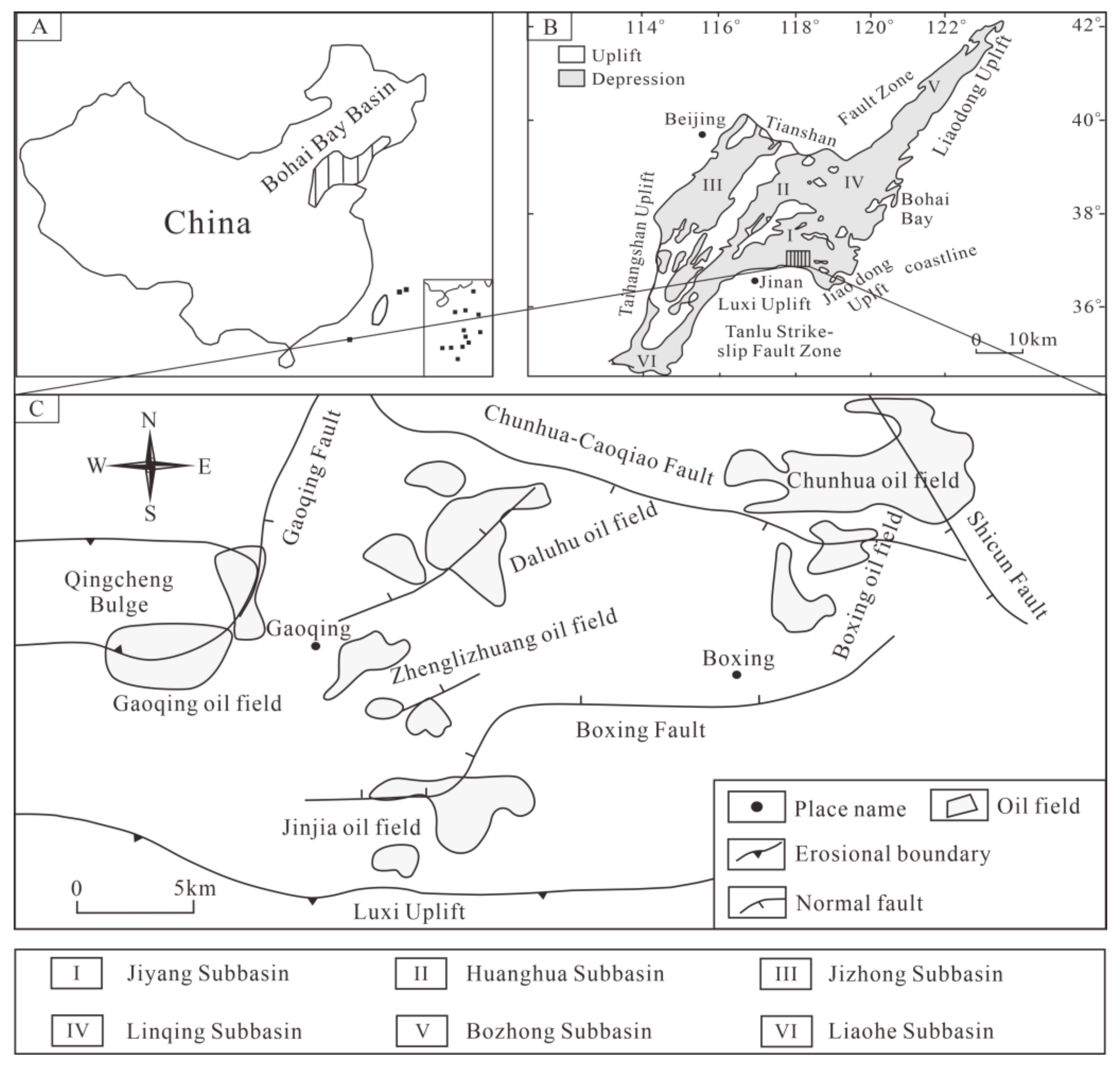
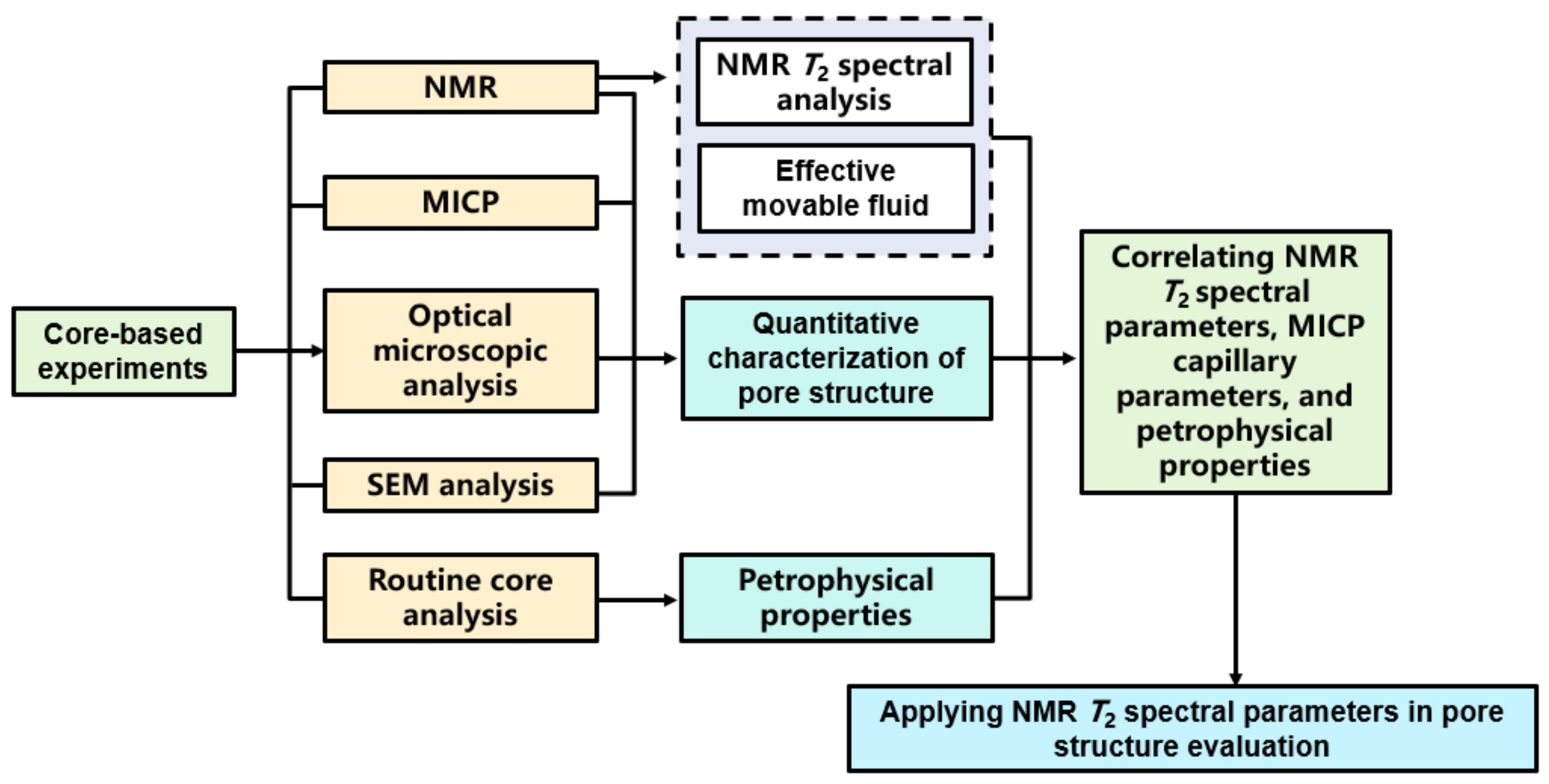
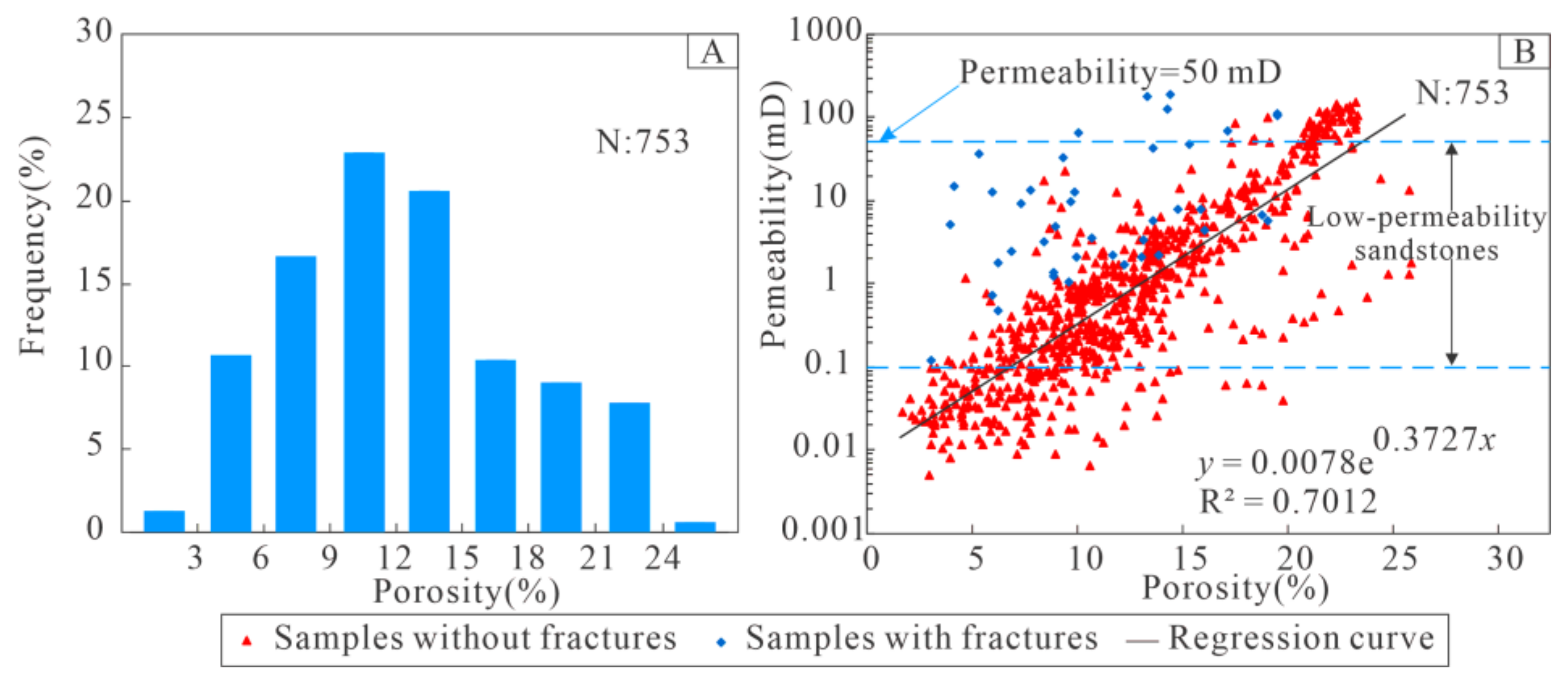

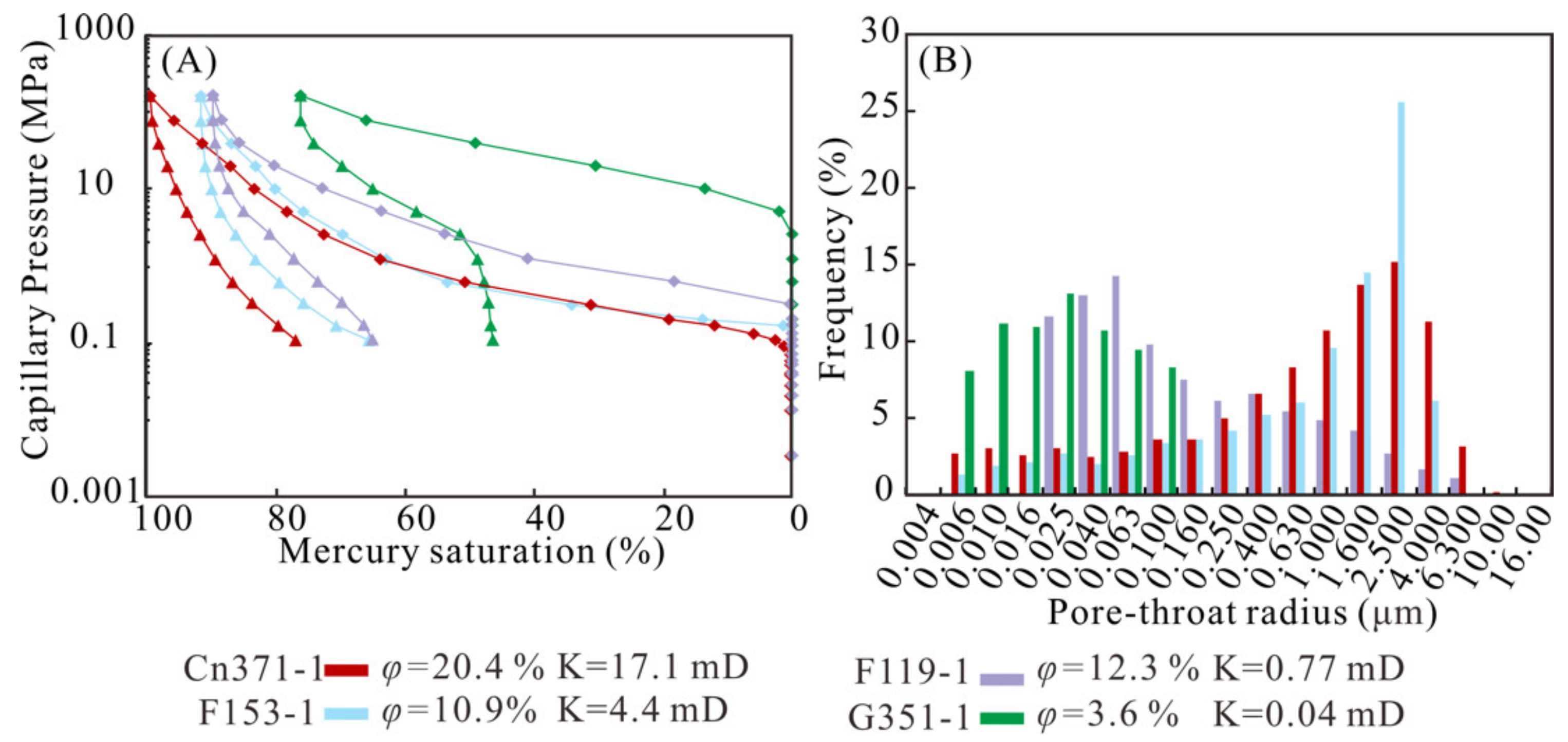
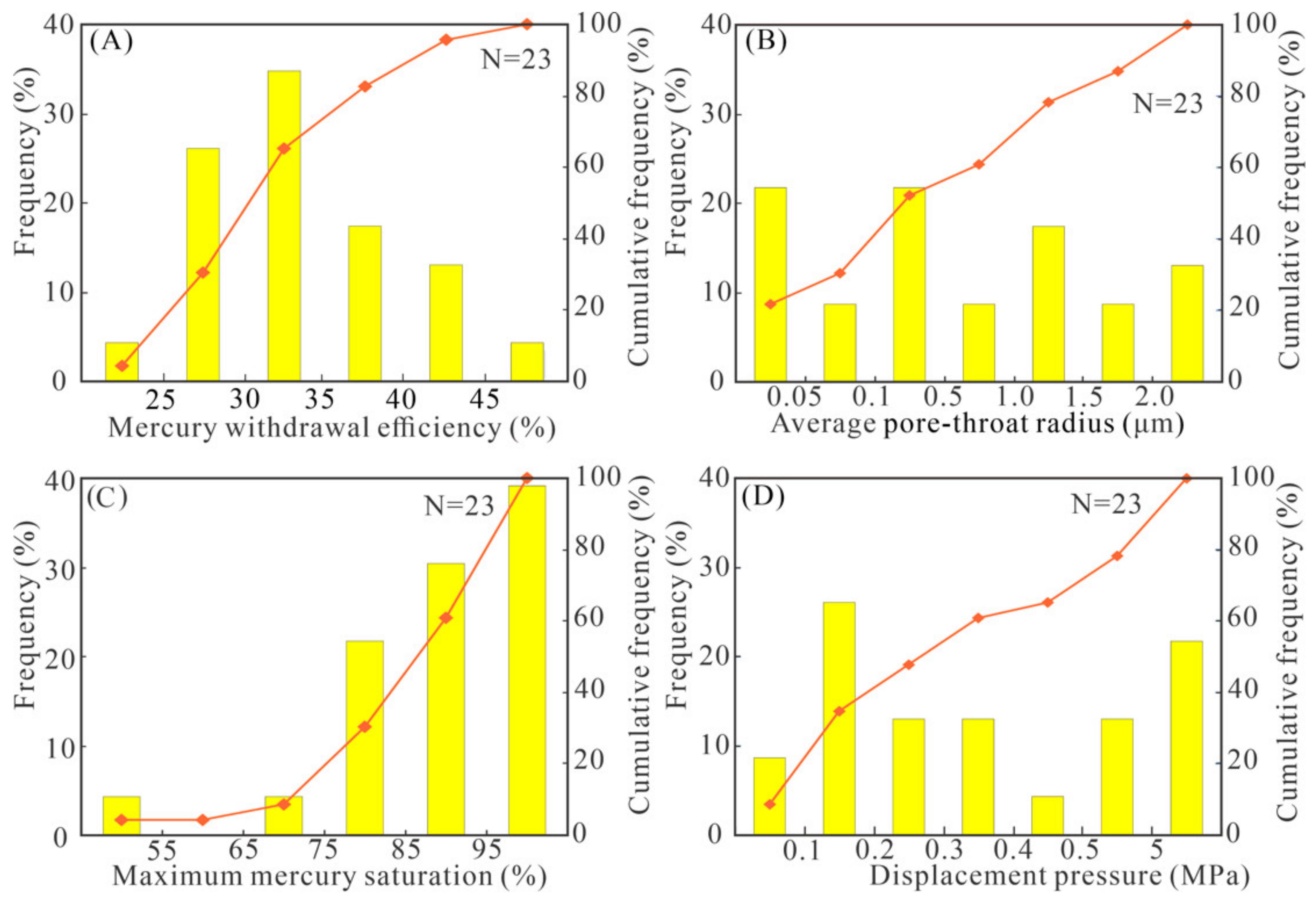

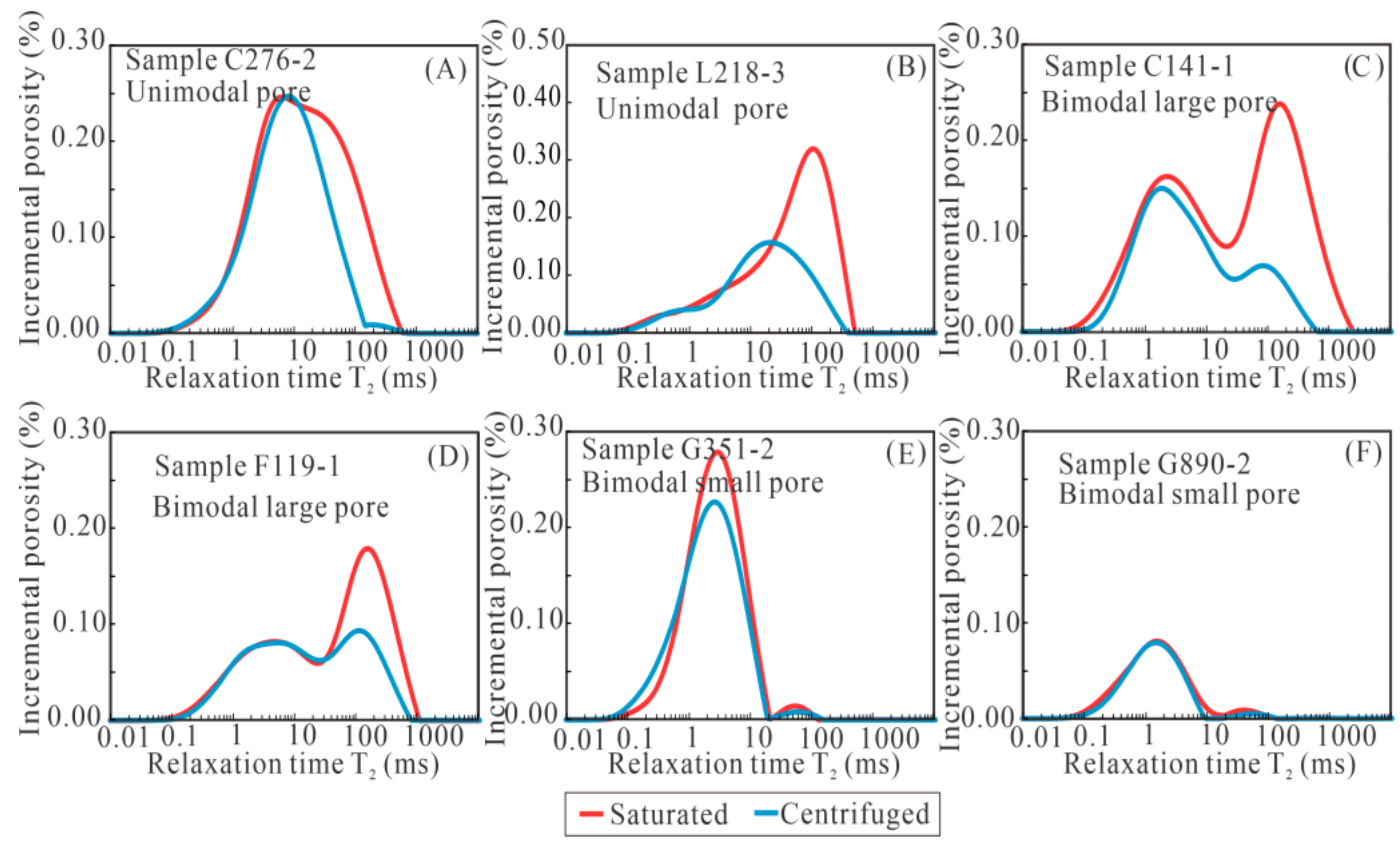
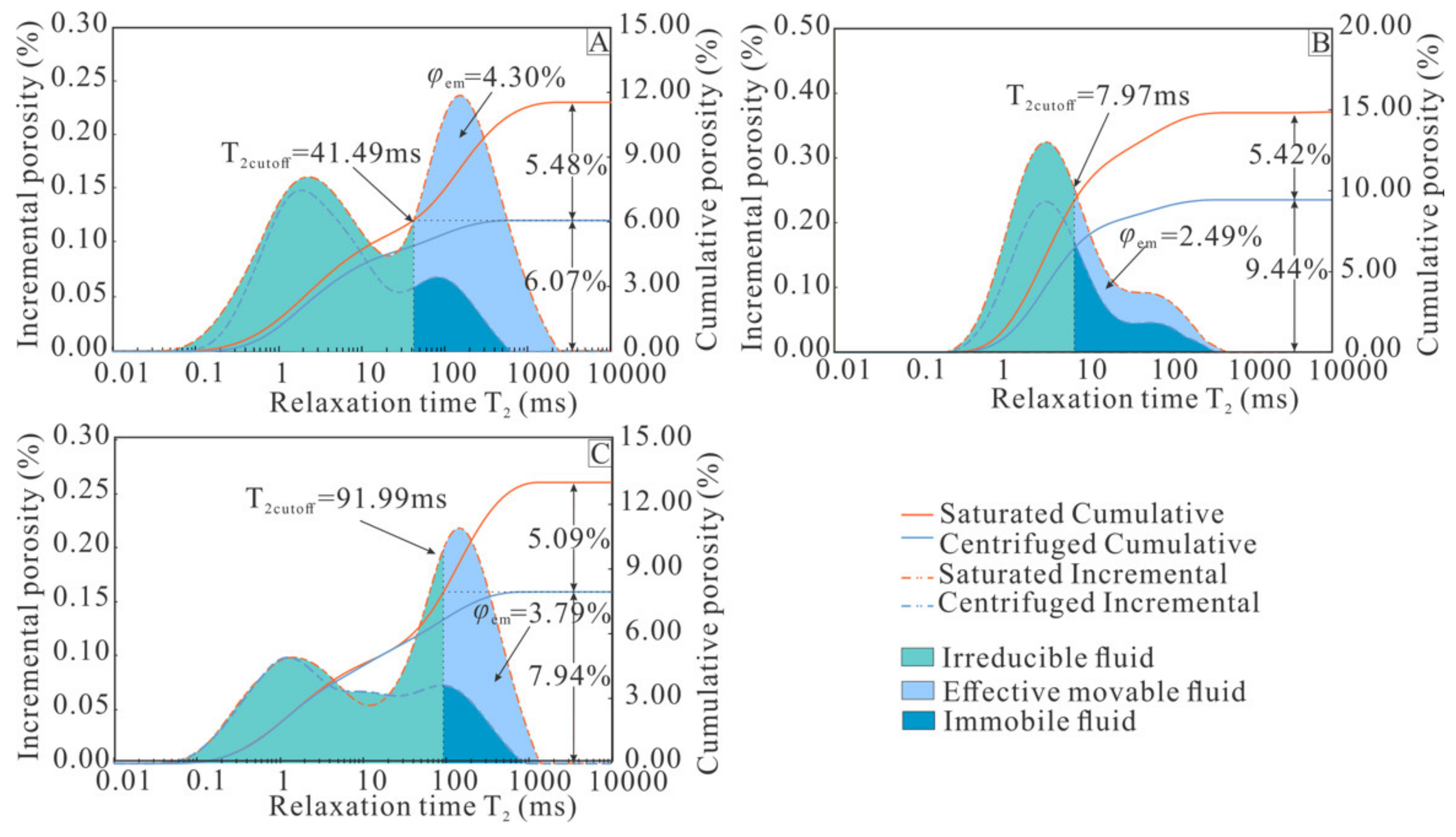
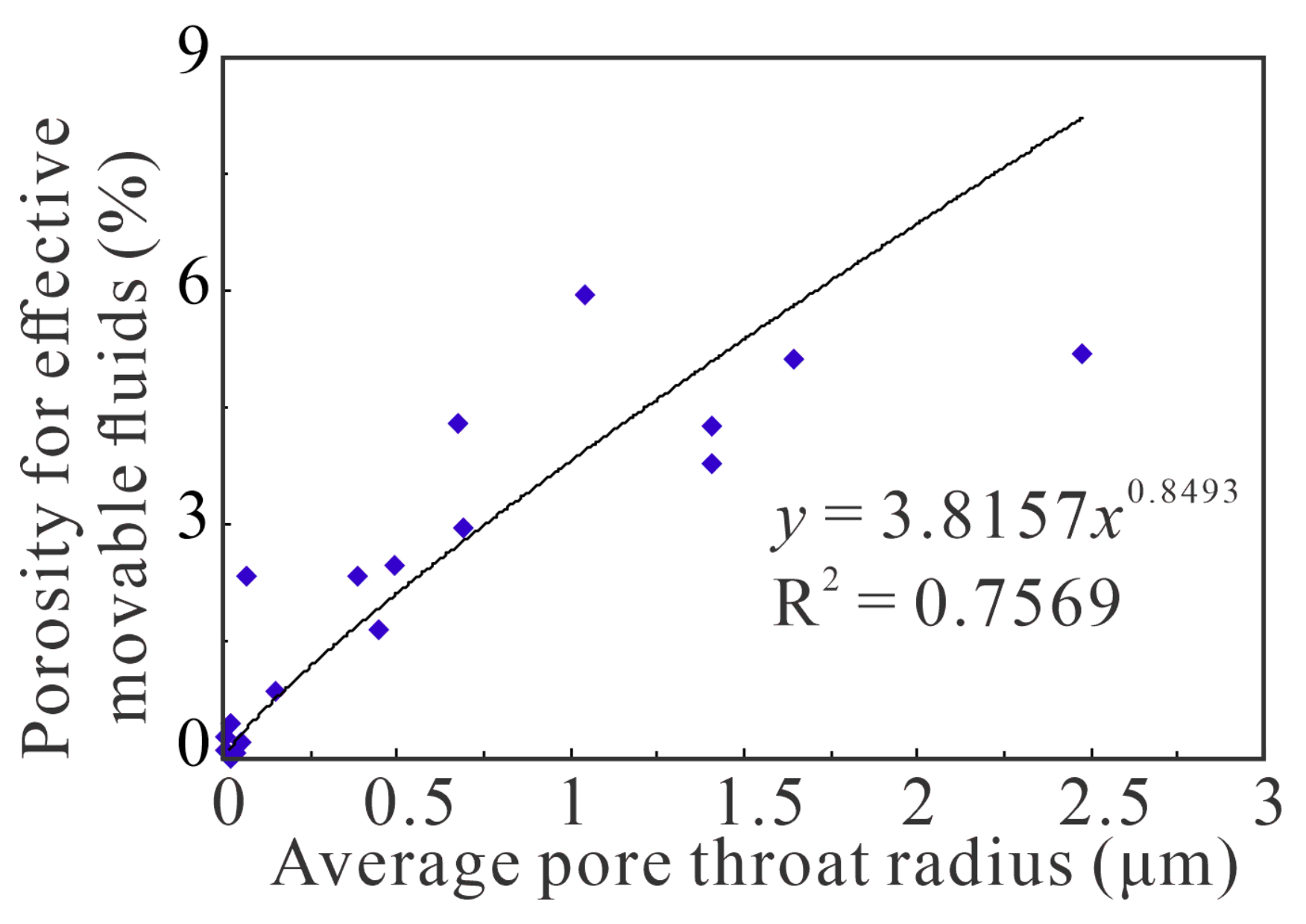

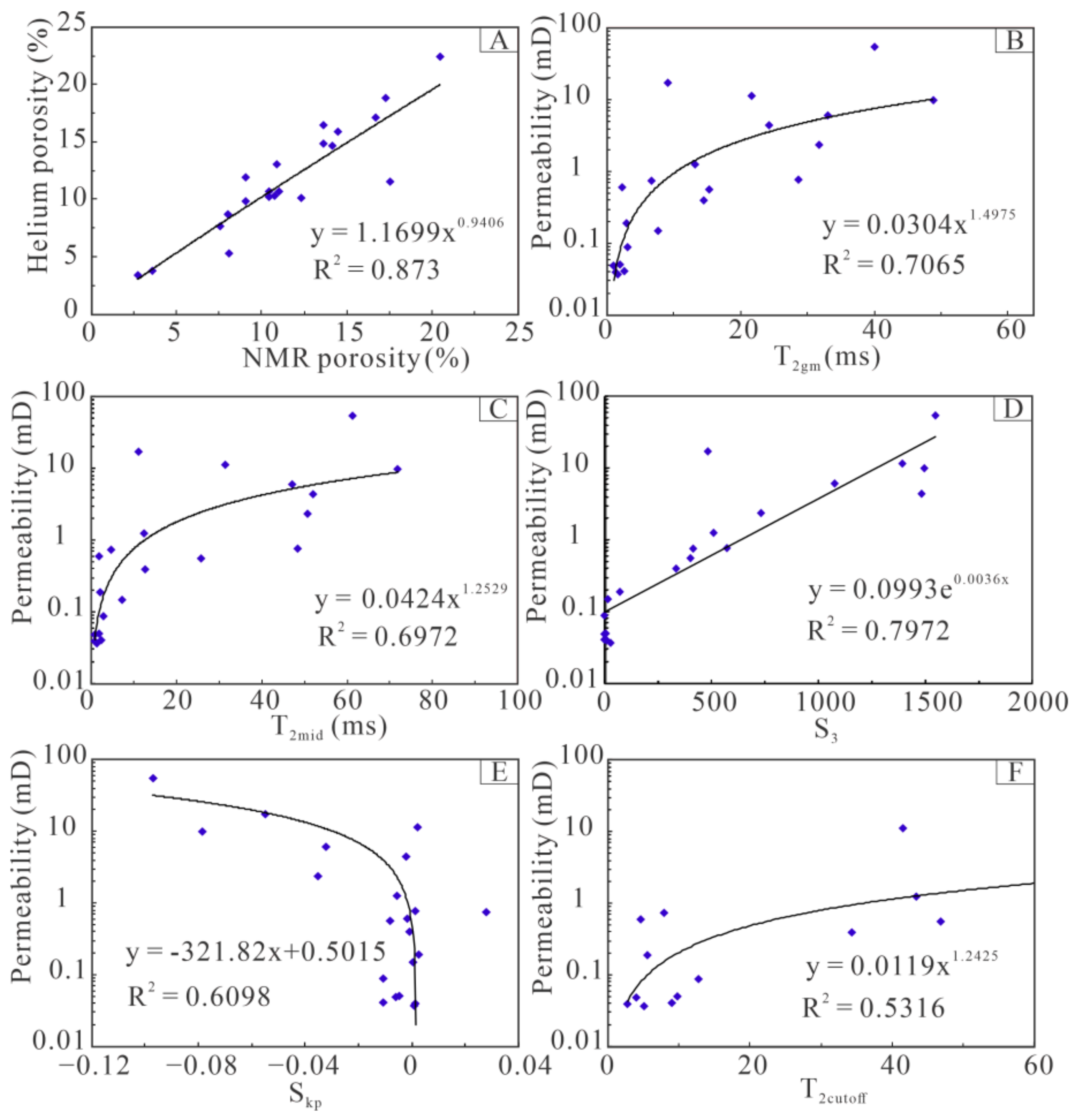
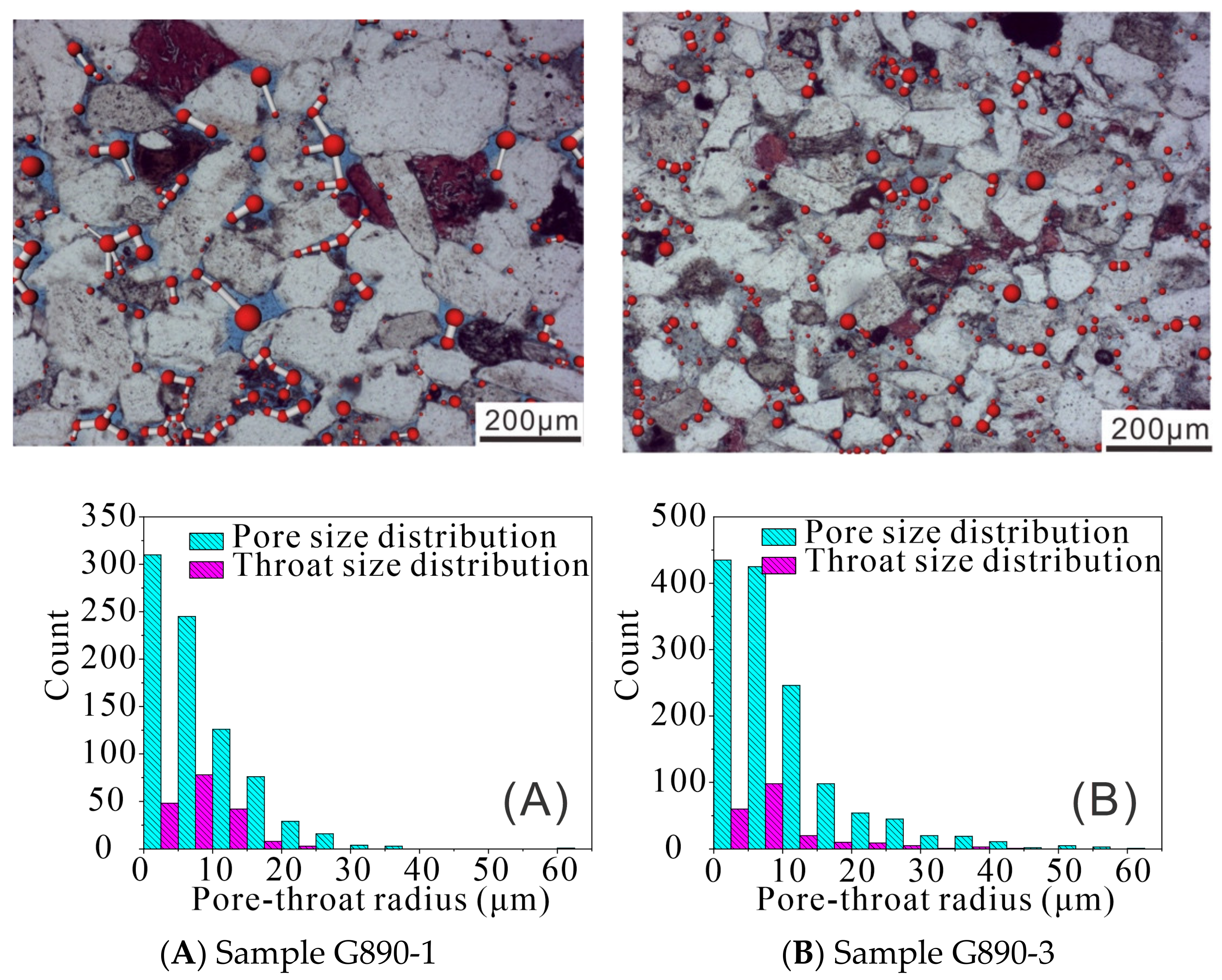
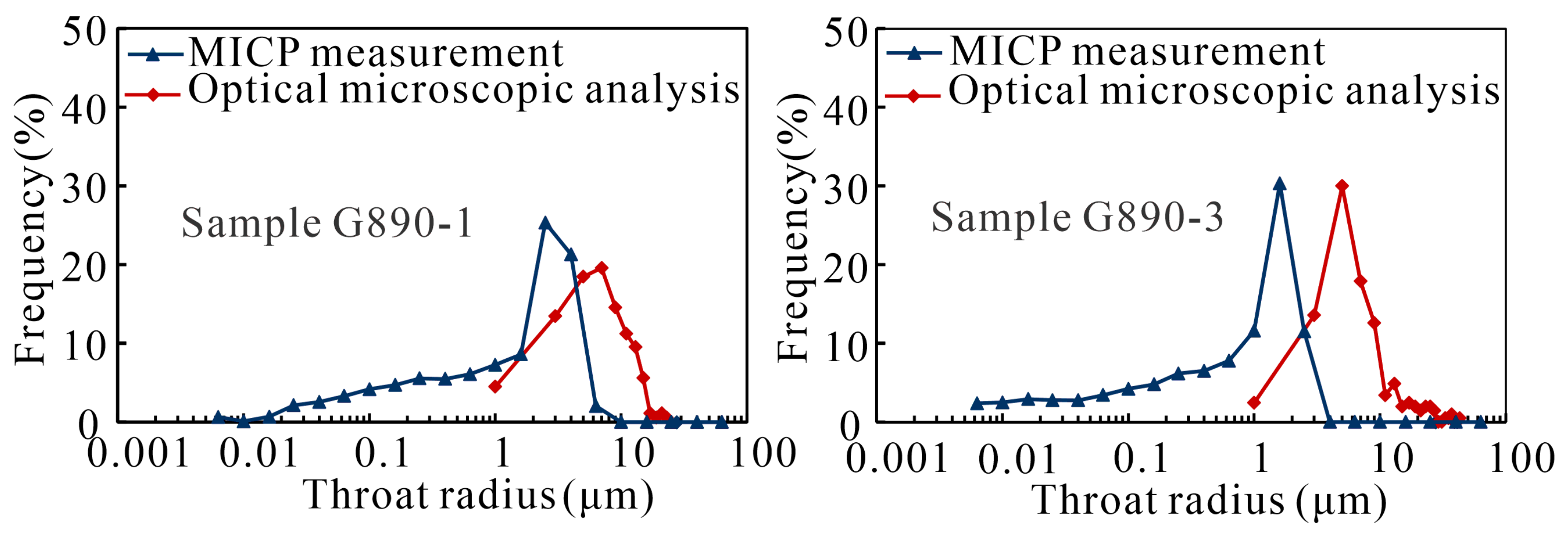

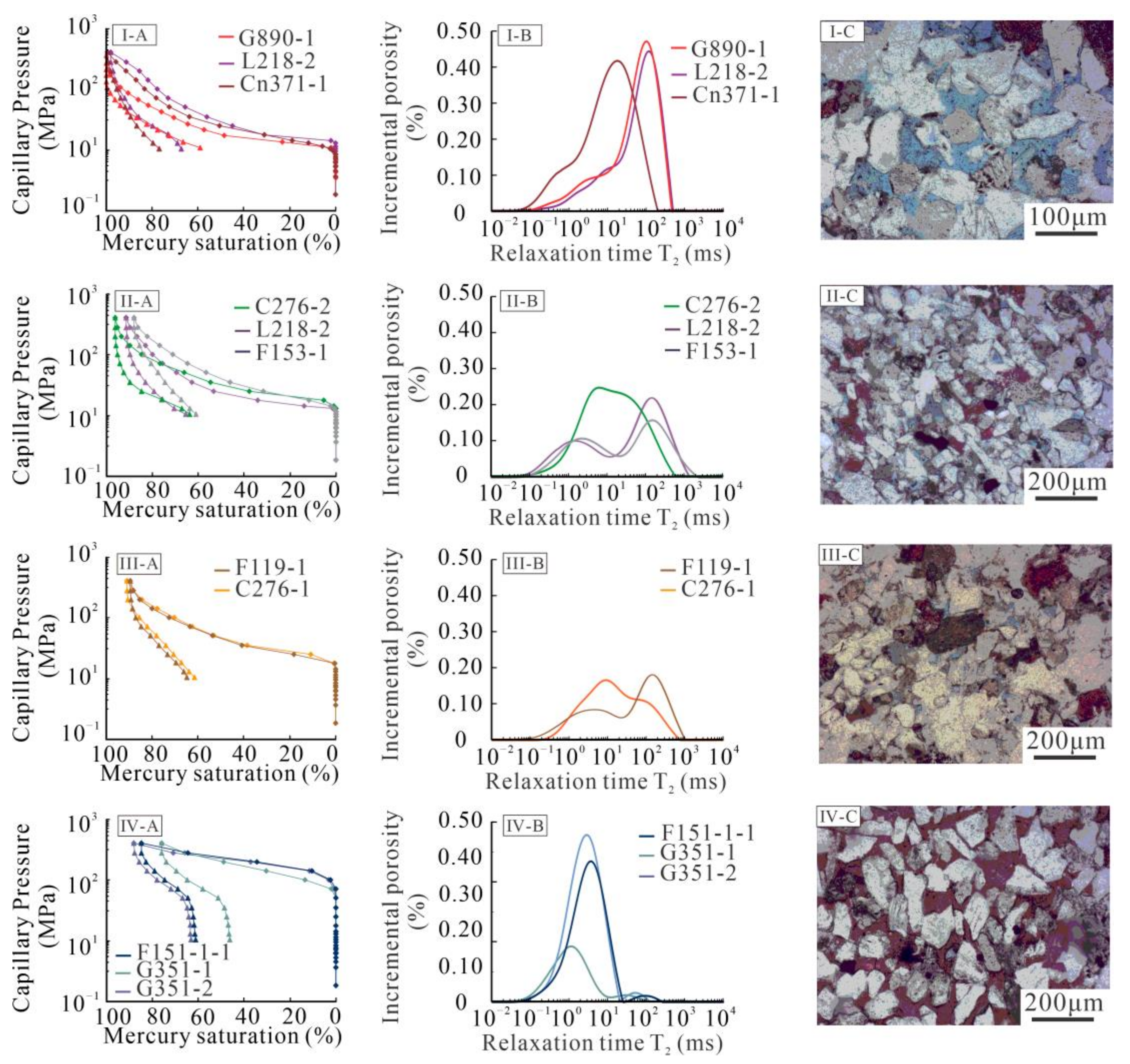

| Sample No. | Core Data | NMR Data | ||||||||||
|---|---|---|---|---|---|---|---|---|---|---|---|---|
| φ (%) | K (mD) | φem (%) | T2max (ms) | T2mid (ms) | T2cutoff (ms) | T2gm (ms) | T2ave (ms) | T2-peak (ms) | φi-max (%) | Swi (%) | Skp | |
| F119-1 | 12.30 | 0.77 | 1.68 | 1084.37 | 48.32 | 150.41 | 28.62 | 118.11 | 155.22 | 0.18 | 72.73 | 0.0013 |
| F119-2 | 8.05 | 0.05 | 0.02 | 135.10 | 0.99 | 3.95 | 1.00 | 2.69 | 1.20 | 0.17 | 97.52 | −0.0062 |
| F143-1 | 10.97 | 0.56 | 2.60 | 310.79 | 25.85 | 46.93 | 15.31 | 45.99 | 62.95 | 0.21 | 64.85 | −0.0080 |
| F151-1-1 | 8.00 | 0.09 | 0.11 | 270.50 | 3.07 | 12.82 | 3.00 | 6.66 | 3.65 | 0.23 | 93.44 | −0.0108 |
| F153-1 | 10.85 | 4.40 | 3.79 | 1431.46 | 52.02 | 91.99 | 24.18 | 126.32 | 144.81 | 0.22 | 60.94 | −0.0020 |
| G351-1 | 3.60 | 0.04 | 0.47 | 117.58 | 1.07 | 2.83 | 1.23 | 6.65 | 1.12 | 0.09 | 80.24 | 0.0014 |
| G351-2 | 10.74 | 0.04 | 0.29 | 126.04 | 2.54 | 8.96 | 2.56 | 4.79 | 2.97 | 0.28 | 90.48 | −0.0108 |
| G890-1 | 17.25 | 54.30 | 5.20 | 541.59 | 61.30 | 84.02 | 39.96 | 87.91 | 102.34 | 0.47 | 60.71 | −0.0970 |
| G890-2 | 2.72 | 0.04 | 0.23 | 144.81 | 1.38 | 5.09 | 1.51 | 11.96 | 1.59 | 0.08 | 86.94 | 0.0010 |
| C141-1 | 17.5 | 11.61 | 4.30 | 2327.20 | 31.50 | 41.49 | 21.63 | 142.49 | 155.22 | 0.16 | 52.55 | 0.0020 |
| C141-2 | 9.06 | 0.61 | 3.01 | 666.99 | 2.08 | 4.72 | 2.27 | 6.66 | 1.38 | 0.21 | 68.48 | −0.0018 |
| C276-1 | 10.42 | 0.40 | 2.36 | 821.43 | 12.67 | 34.36 | 14.40 | 50.94 | 9.01 | 0.17 | 68.53 | −0.0009 |
| C276-2 | 13.60 | 1.26 | 2.97 | 880.49 | 12.56 | 43.45 | 13.08 | 40.60 | 6.37 | 0.25 | 74.79 | −0.0056 |
| C406-1 | 13.61 | 0.76 | 2.49 | 580.52 | 4.83 | 7.97 | 6.56 | 44.95 | 3.65 | 0.32 | 63.53 | 0.0280 |
| Cn371-1 | 20.44 | 17.13 | / | 943.79 | 11.23 | / | 9.07 | 23.24 | 18.04 | 0.42 | / | −0.0548 |
| L218-1 | 16.65 | 10.01 | 5.98 | 505.26 | 71.80 | 85.61 | 48.74 | 99.95 | 117.58 | 0.44 | 56.01 | −0.0785 |
| L218-2 | 14.47 | 6.12 | 5.15 | 505.26 | 47.11 | 64.88 | 33.00 | 79.25 | 102.34 | 0.33 | 58.41 | −0.0322 |
| L218-3 | 14.11 | 2.37 | 4.32 | 505.26 | 50.66 | 76.98 | 31.63 | 81.90 | 102.34 | 0.32 | 61.78 | −0.0353 |
| L752-1 | 10.43 | 0.15 | 0.87 | 289.94 | 7.49 | 63.97 | 7.57 | 30.43 | 54.79 | 0.14 | 83.63 | 0.0003 |
| L752-2 | 9.07 | 0.19 | 2.35 | 541.73 | 2.25 | 5.53 | 2.95 | 14.34 | 1.70 | 0.18 | 68.44 | 0.0025 |
| L752-3 | 7.57 | 0.05 | 0.08 | 191.16 | 1.91 | 9.88 | 1.98 | 4.37 | 2.10 | 0.22 | 96.57 | −0.0046 |
| Type | T2mid (ms) | T2max (ms) | T2ave (ms) | T2gm (ms) | φi-max (%) | S3 | Swi (%) | φem (%) |
|---|---|---|---|---|---|---|---|---|
| I | 11.23~71.80/43.96 | 505.26~2327.20/1079.46 | 23.24~142.49/88.40 | 9.07~48.74/29.85 | 0.16~0.47/0.37 | 483.80~1547.59/1229.92 | 52.55~60.71/56.42 | 4.3~5.98/5.16 |
| II | 12.56~52.02/40.59 | 505.26~1431.46/830.62 | 40.60~126.32/82.02 | 13.08~33.0/25.47 | 0.22~0.33/0.28 | 510.09~1482.50/950.21 | 58.41~74.79/63.89 | 2.97~5.15/4.06 |
| III | 2.08~48.32/14.78 | 289.94~1084.37/613.68 | 6.66~118.11/44.49 | 2.27~28.62/11.10 | 0.14~0.32/0.20 | 16.29~572.47/302.33 | 63.53~83.63/70.03 | 0.87~3.01/2.19 |
| Ⅳ | 0.99~3.07/1.83 | 117.58~270.50/ 164.20 | 2.69~11.96/6.19 | 1.0~3.0/1.88 | 0.08~0.28/0.18 | 0~33.23/8.62 | 80.24~97.52/90.87 | 0.02~0.47/0.20 |
Publisher’s Note: MDPI stays neutral with regard to jurisdictional claims in published maps and institutional affiliations. |
© 2021 by the authors. Licensee MDPI, Basel, Switzerland. This article is an open access article distributed under the terms and conditions of the Creative Commons Attribution (CC BY) license (https://creativecommons.org/licenses/by/4.0/).
Share and Cite
Lu, Y.; Liu, K.; Wang, Y. Applying NMR T2 Spectral Parameters in Pore Structure Evaluation—An Example from an Eocene Low-Permeability Sandstone Reservoir. Appl. Sci. 2021, 11, 8027. https://doi.org/10.3390/app11178027
Lu Y, Liu K, Wang Y. Applying NMR T2 Spectral Parameters in Pore Structure Evaluation—An Example from an Eocene Low-Permeability Sandstone Reservoir. Applied Sciences. 2021; 11(17):8027. https://doi.org/10.3390/app11178027
Chicago/Turabian StyleLu, Yan, Keyu Liu, and Ya Wang. 2021. "Applying NMR T2 Spectral Parameters in Pore Structure Evaluation—An Example from an Eocene Low-Permeability Sandstone Reservoir" Applied Sciences 11, no. 17: 8027. https://doi.org/10.3390/app11178027






